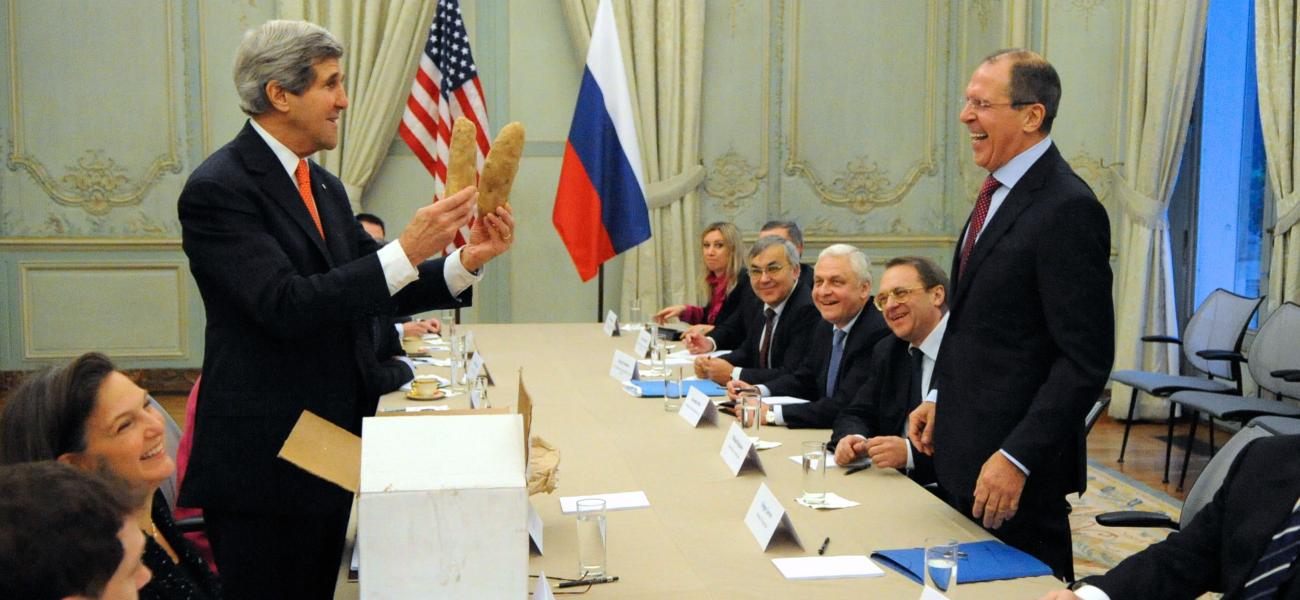
Keys, Hurdles, Strategies: US-Russia Relations Under Trump
The most recent event co-hosted by Russia Matters focused on U.S.-Russia relations under incoming U.S. President Donald Trump. Here are the three speakers’ key points in the order presented (all of them spoke in a personal capacity):
NATIONAL INTERESTS
Simon Saradzhyan, director of the Russia Matters Project, focused on the convergences and divergences in the two countries’ national interests (see table below). To emphasize the importance of those interests, he began by pointing out that many people quote Winston Churchill’s “riddle wrapped in a mystery” description of Russia without mentioning how the statement ends: “I cannot forecast to you the action of Russia. It is a riddle wrapped in a mystery inside an enigma, but perhaps there is a key. That key is Russian national interest.” Saradzhyan noted that U.S. and Russian vital interests converge in a number of areas, yet such convergence has not translated into a sustainable and lasting partnership. He cited disagreements between the two countries over such issues as NATO expansion, “color revolutions” and missile defense, as well as the lack of a robust economic relationship, among the obstacles that have prevented the emergence of such a partnership.
OBSTACLES TO RAPPROCHEMENT
Prof. Nikolas Gvosdev of the U.S. Naval War College also discussed some of the obstacles and barriers to improved U.S.-Russia relations under the new administration in Washington, expanding on points he has made in two recent pieces for The National Interest and one on this website. He pointed out that Putin will not be swayed by rhetoric or promises and his approach to Trump will be “show me what you can deliver.” Some of the problems the new U.S. president will likely face in any attempts to improve relations, Gvosdev argued, include: Cabinet picks who aren’t on the same page with him about Russia; high-profile summit pledges getting lost in DC bureaucracy; a hostile Congress. As an example, he cited the decades-long effort to graduate Russia from the Jackson-Vanik amendment, which stayed on the books long beyond its initial purpose as members of Congress were loath to give up leverage over Russia’s behavior. Furthermore, compromising with Russia could demand two hard-to-deliver things from the new president: trade-offs with powerful groups in Washington and backing down from earlier U.S. positions and commitments.
TRUMP’S EMERGING STRATEGY ON RUSSIA
William Tobey, a senior fellow at Harvard’s Belfer Center and director of its U.S.-Russia Initiative to Prevent Nuclear Terrorism, analyzed the public statements on Russia made by Trump and those he has selected to serve in top positions. From these he drew four main conclusions:
- The new U.S. administration sees foreign policy primarily in terms of its effects on domestic issues—for example, critiques of trade, immigration, and alliance policies are framed by their direct implications for American citizens—and this perspective will likely inform policy on Russia.
- While it is easy to caricature Trump’s tweets and flamboyant statements, it may very well be wrong to do so. His opponents have consistently underestimated him; moreover, some statements are probably intended to create trade space in negotiations.
- It is possible to infer an internally consistent strategy from the statements we have seen so far: (a) ruthlessly prioritize perceived threats to U.S. interests—first, the Islamic State, and second Chinese trade practices and aggressive regional behavior—while disengaging on lesser issues; (b) defend more forcefully core U.S. interests, while accommodating Russia on its perceived vital interests—hence the apparent welcoming of an arms race (presumably with Russia), while questioning the need for U.S. leadership on Ukraine; (c) if a rising China, not a declining Russia, poses the main strategic threat to U.S. interests, keep Moscow at least neutral—this is an updated version of Kissinger’s balancing.
- Much remains to be sorted out on Russia among the administration’s senior officials: Tillerson, Mattis and Pompeo have all spoken more skeptically of Russia and more favorably of U.S. alliances than Trump.
| Russia’s vital national interests (in order of importance): |
U.S. vital national interests: |
Converge / Diverge / No equivalent: |
|---|---|---|
|
|
|
|
|
|
|
|
|
|
|
|
|
|
|
|
|
|
|
|
|
|
|
|
Total: Diverge = 2; Converge = 4; No equivalent = 1.
PDF download available here:
Updated Jan. 24, 2017, with a fuller rendering of William Tobey's points.
The opinions expressed in this commentary are solely those of the author.
